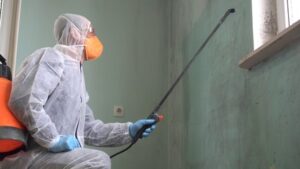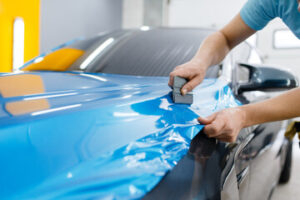Mold and mildew need two things to grow: moisture and a food source. That food is organic material that can be found in many different parts of your home.
Most varieties of mold are harmless but some like Stachybotrys chartarum can produce toxic spores that penetrate surfaces and cause further damage. To prevent this, we recommend acting fast to address the issue as soon as it’s noticed. Click https://utahmoldremovalandremediation.com to learn more.

The first step in a mold clean up is to isolate the area and keep the spread of spores to a minimum. Then a trained MRS will inspect the property to determine what needs to be done next.
Depending on the severity of the mold problem, this could involve cleaning non-porous surfaces, disposing of porous materials and sanitizing air and water systems to remove spores and toxins. It also may involve addressing the factors that led to mold growth in the first place, like repairing leaks and controlling humidity levels.
Non-porous surfaces that have been affected by mold can be cleaned with bleach, detergents and household cleaners. It is important to use rubber gloves, goggles and a mask during any cleaning process to avoid direct contact with the spores. It is also important to open windows and doors for ventilation when using any cleaning products.
More natural cleaning methods can also be used, particularly on hard surfaces such as drywall. A mix of two cups of hot water, one tablespoon of borax and one cup of vinegar can be sprayed onto the surface, scrubbed with a brush and then rinsed. The same method can be applied to wood surfaces, although it is recommended that you seek advice from a museum technician or conservation professional before proceeding with this.
Once the surface has been cleaned, it is crucial to dry the area thoroughly. This can be a difficult task, but fans and dehumidifiers should be set up to speed the process and reduce humidity levels.
Navigating Belongings After Mold: What Stays and What Goes
Once you have finished cleaning, it is important to sort out your belongings. Some items will be too damaged or contaminated by the mold to be salvageable, and these should be disposed of in a safe manner. Others, such as furniture and carpets, may be able to be saved if they are removed from the area and dried quickly.
Be sure to vacuum and dust all areas of the home, as this will eliminate a key source of nutrients for mold. It is also a good idea to have your air conditioning system cleaned and change the filter regularly, as this will help to remove spores from the air.
Disinfecting
Mold spores are everywhere in nature and our immune systems can handle them, but when they become airborne and find themselves trapped inside a home they cause a lot of problems. They can aggravate allergies, cause respiratory issues and lead to the development of mycotoxins that can stick to surfaces like drywall and carpets making them much more difficult to clean.
After a thorough inspection the first step in the remediation process is containment and air filtration. This is done to reduce the number of mold spores that become airborne and potentially spread the fungus to unaffected areas in the home. Next comes cleaning and disinfecting all the affected surfaces with appropriate cleaners and biocide/fungicide/moldicide solutions. This includes the scrubbing of hard surfaces and the spraying and scrubbing of porous materials. It is also at this stage that all contaminated materials are discarded in plastic bags to prevent mold spores from spreading to other parts of the house.
Absorbent surfaces like drywall, ceiling tiles and carpet will need to be removed and replaced after being cleaned because they are likely too contaminated to be salvaged. Depending on the severity of the contamination, this may be an easy or a complicated job and may require the assistance of a professional.
Other items, such as furniture and clothing, are usually too heavily contaminated with mold to be salvaged and will need to be discarded properly. This is important to do in order to prevent the spread of mold spores and other allergens around the home. It is always advisable to double bag and dispose of these items carefully to avoid any further contamination.
Mold growth can be prevented by fixing leaks as soon as they appear, by scrubbing hard surfaces with detergent and water and by thoroughly drying all items and fabrics. It is a good idea to check storage areas such as attics, cellars and closets for signs of mold regularly, as these are often overlooked. Mold is more likely to grow in damp and humid environments, so the use of fans and dehumidifiers will help to speed up and decrease humidity levels in rooms where mold growth has occurred.
Remediation
When mold is disturbed, it releases microscopic spores into the air that cling to surfaces and other organic material. These spores can carry and distribute mold from place to place as long as moisture and oxygen are present. Often, these spores are not visible to the naked eye and can be a significant threat to those with respiratory issues or allergies.
Remediation is the process of identifying large-scale mold growth and eradicating or encapsulating it. This can include a comprehensive inspection and evaluation of the property. It also involves restoring any materials and structures that have been damaged by the mold, including drywall, insulation, carpeting and flooring. Often, a thorough cleaning and sanitization of the affected area is necessary as well.
During the remediation process, professionals typically use physical barriers and negative air pressure to contain the mold and prevent spores from spreading to unaffected areas. They may also use specialized cleaning tools and disinfectant solutions. This step is often one of the most labor intensive and time consuming.
After the cleaning and sanitization have been completed, it is important to ensure that all affected materials are completely dry. This can be accomplished by using dehumidifiers or fans to speed up the drying process. Once the moisture levels have been addressed and the mold is gone, the home can be restored and reoccupied.
When selecting a company to perform remediation, it is important to choose a professional with experience. Checking references and asking for recommendations can help homeowners find a contractor that is safe and reliable. It is also recommended to follow the recommendations in the EPA’s guide, Mold Remediation in Schools and Commercial Buildings, and guidelines from professional or government organizations. This will ensure that the mold is fully removed and that the underlying conditions that caused it are addressed. This can help prevent future mold problems in the same location or other parts of the home.
Contents Pack Out
Mold is already thriving in our Alabama climate, so you don’t want to create an environment that encourages more growth. It’s best to work outside if possible, but if you can’t, make sure you have personal protective equipment ready before you start the cleaning process. This should include aprons or lab coats, disposable gloves (nitrile is best), and masks that are fit tested and approved for use with mold spores. You should also wear a respirator mask when vacuuming contaminated items, as well as a dust mask for any non-moldy debris you may encounter. A face mask with a filter that will remove both fine and coarse particulate matter is also an option.
Mold spores and their smell can linger even after the mold is cleaned and disinfected. This can be remedied by using a spray cleaner that kills mildew and mold spores but doesn’t bleach or damage the material it is applied to. This spray is available in most home improvement stores and is a great item to have on hand.
Another option is to neutralize the odor in-house by setting up a makeshift neutralization chamber. This involves placing a large bin with a sealable lid inside of a smaller bin. In the larger bin, place baking soda, kitty litter or plain charcoal briquettes to act as the neutralizer. Place the records in the smaller bin. Then place the bins in a sheltered area with low humidity where the records will stay for two days to dry out and deactivate the mold.
If the weather is not cooperating, you can still air dry moldy items to deactivate them. Place the items on a sheet or piece of paper in direct sunlight for no more than an hour. This should also be done for records that have pastel or charcoal drawings on them, as they will bleach.
After the items have been treated and sanitized they should be inspected for moisture and stored in a clean area until they can be returned to their homes. If you are hiring a remediator to treat your home, ask them if they will rent you a storage unit where they can store the items after treatment so that you can test their work before bringing them back into your home.



